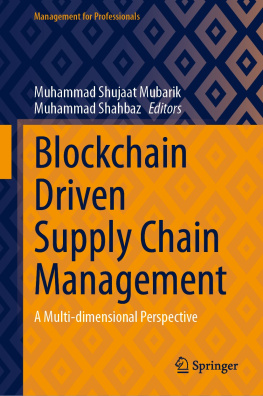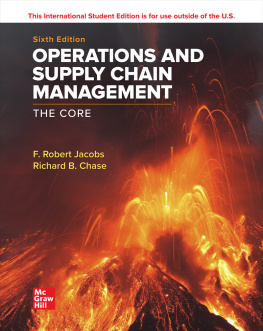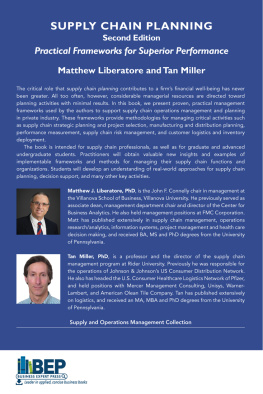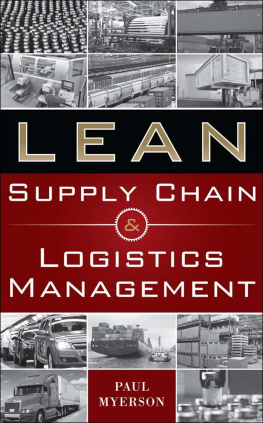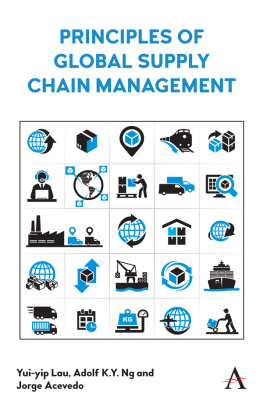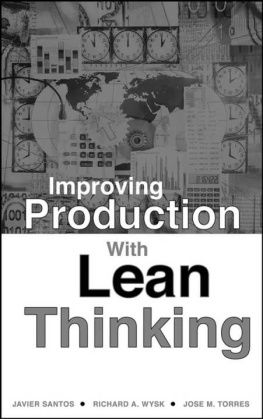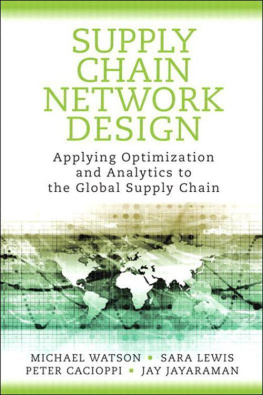Building Lean Supply Chains with the Theory of Constraints
About the Author
Mandyam M. Srinivasan is the Pilot Corporation Chair of Excellence at the University of Tennessee. He is the author of Streamlined: 14 Principles for Building and Managing the Lean Supply Chain (Cengage, 2004), and coauthor of Supply Chain Management for Competitive Advantage (Tata McGraw-Hill, 2009). Dr. Srinivasan has many years of work experience with leading automobile manufacturing organizations, and he has consulted with a large number of industries.
Building Lean Supply Chains with the Theory of Constraints
Mandyam M. Srinivasan


Copyright 2012 by The McGraw-Hill Companies, Inc. All rights reserved. Except as permitted under the United States Copyright Act of 1976, no part of this publication may be reproduced or distributed in any form or by any means, or stored in a database or retrieval system, without the prior written permission of the publisher.
ISBN: 978-0-07-177122-1
MHID: 0-07-177122-0
The material in this eBook also appears in the print version of this title: ISBN: 978-0-07-177121-4, MHID: 0-07-177121-2.
All trademarks are trademarks of their respective owners. Rather than put a trademark symbol after every occurrence of a trademarked name, we use names in an editorial fashion only, and to the benefit of the trademark owner, with no intention of infringement of the trademark. Where such designations appear in this book, they have been printed with initial caps.
McGraw-Hill eBooks are available at special quantity discounts to use as premiums and sales promotions, or for use in corporate training programs. To contact a representative please e-mail us at bulksales@mcgraw-hill.com.
Information contained in this work has been obtained by The McGraw-Hill Companies, Inc. (McGraw-Hill) from sources believed to be reliable. However, neither McGraw-Hill nor its authors guarantee the accuracy or completeness of any information published herein, and neither McGraw-Hill nor its authors shall be responsible for any errors, omissions, or damages arising out of use of this information. This work is published with the understanding that McGraw-Hill and its authors are supplying information but are not attempting to render engineering or other professional services. If such services are required, the assistance of an appropriate professional should be sought.
TERMS OF USE
This is a copyrighted work and The McGraw-Hill Companies, Inc. (McGraw-Hill) and its licensors reserve all rights in and to the work. Use of this work is subject to these terms. Except as permitted under the Copyright Act of 1976 and the right to store and retrieve one copy of the work, you may not decompile, disassemble, reverse engineer, reproduce, modify, create derivative works based upon, transmit, distribute, disseminate, sell, publish or sublicense the work or any part of it without McGraw-Hills prior consent. You may use the work for your own noncommercial and personal use; any other use of the work is strictly prohibited. Your right to use the work may be terminated if you fail to comply with these terms.
THE WORK IS PROVIDED AS IS. McGRAW-HILL AND ITS LICENSORS MAKE NO GUARANTEES OR WARRANTIES AS TO THE ACCURACY, ADEQUACY OR COMPLETENESS OF OR RESULTS TO BE OBTAINED FROM USING THE WORK, INCLUDING ANY INFORMATION THAT CAN BE ACCESSED THROUGH THE WORK VIA HYPERLINK OR OTHERWISE, AND EXPRESSLY DISCLAIM ANY WARRANTY, EXPRESS OR IMPLIED, INCLUDING BUT NOT LIMITED TO IMPLIED WARRANTIES OF MERCHANTABILITY OR FITNESS FOR A PARTICULAR PURPOSE. McGraw-Hill and its licensors do not warrant or guarantee that the functions contained in the work will meet your requirements or that its operation will be uninterrupted or error free. Neither McGraw-Hill nor its licensors shall be liable to you or anyone else for any inaccuracy, error or omission, regardless of cause, in the work or for any damages resulting therefrom. McGraw-Hill has no responsibility for the content of any information accessed through the work. Under no circumstances shall McGraw-Hill and/or its licensors be liable for any indirect, incidental, special, punitive, consequential or similar damages that result from the use of or inability to use the work, even if any of them has been advised of the possibility of such damages. This limitation of liability shall apply to any claim or cause whatsoever whether such claim or cause arises in contract, tort or otherwise.
To my mother, Mythili; my wife, Kanchan; and my daughters, Tanu and Madhu
CONTENTS
.
.
.
.
.
.
.
.
.
FOREWORD
Throughout my 30-year career in the aerospace industry, I have witnessed unparalleled technological advancements in aeronautical systems and capabilities, as well as ground-breaking changes in our business operations. The defense technology and industrial base is now a global network with global suppliers, and our challenge is to manage the resources, skills, competencies, and tools within the network through all phases of the product life cycle.
As enterprises such as ours strive to create and deliver competitive products in this global marketplace, it is more critical than ever to develop and maintain a lean supply chain. But what is the definition of a lean supply chain, and how can an organization achieve this ideal? Dr. Srinivasans book, Building Lean Supply Chains with the Theory of Constraints, answers this question and more because he provides an in-depth look at todays lean supply chains and offers a detailed plan on how to realize them.
Outlining a seven-step roadmap that enterprises can use on their lean supply chain journey, Dr. Srinivasan applies Theory of Constraints (TOC) concepts to supply chain management in a thought-provoking and pragmatic way. The book intimately explores building and managing a lean supply chain from an operations and logistics perspective, with Lean and TOC principles combined. Not only does Dr. Srinivasan tackle the importance of systems thinking, but he also applies TOC philosophies to throughput, meeting and anticipating customer needs, delivery requirements, collaboration, and improved visibility of the supply chain, among others.
As Dr. Srinivasan expounds on his seven-step roadmap, he lays the groundwork for what a lean supply chain should look like. Weaving in 16 Lean Supply Chain Principles, the result is a framework that enterprises can use to create and manage their lean supply chains.
In this book, lean supply chains are not assayed from one angle but are considered from multiple vantage points. The initial chapters investigate the hurdles and structure of the lean supply chain, introducing the Theory of Constraints to enhance Lean supply chain performance. Throughout the book, Dr. Srinivasan leverages real-world scenarios to drive home the necessity of merging Lean and TOC principles.
While this book looks at an integrated approach to supply chain management and sets the expectation that industries partner with the supply chain, Dr. Srinivasans vision never loses sight of the customer. At Lockheed Martin, our customer is our focus, and we realize that collaborative relationships are the key to our current and future successes, especially when building fifth-generation aircraft such as the F-35 with a supply chain that spans the globe. As we learn more about these relationships in the global market in which we work, we can better understand our customers needs and plan for tomorrow.
Next page

